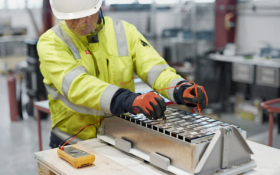Japanese car company Nissan is to use second-life EV batteries to power its new French office, the largest ever grid-integrated EV system in a building in the world.
Sixty-four used lithium-ion batteries from Nissan Leafs combined with solar generation will comprise the 1 MWh energy storage system, with 100 vehicle-to-grid chargers from Nissan’s partner Enel installed.
The new building will allow Nissan’s range of EVs to charge using energy from the grid at off-peak periods with the ability to “sell back” the stored energy to the grid.
Nissan was the first EV maker to launch a full-scale commercial unit using re-purposed batteries rather than new ones, installing the system at one of its facilities in June 2015.
At the COP21 climate conference in Paris last year, the firm announced a partnership between itself and power management company Eaton in developing second-life EV batteries into stationary energy storage units.
Nissan is reportedly hoping to extend this battery technology to other major Nissan sites and facilities around the world over the next few years.
The new technology is expected to slash energy costs at the new France office by reducing drawdown of energy during peak periods in favour of off-peak tariffs. The new energy management system will also decrease the amount of contracted power consumed from the local electricity supplier.
Other French car firms are joining the drive to find a use for ‘second-life’ EV batteries. In February, UK-based Connected Energy announced it would partner Renault to produce an energy storage system E-STOR, which uses Renault’s EV battery packs.












